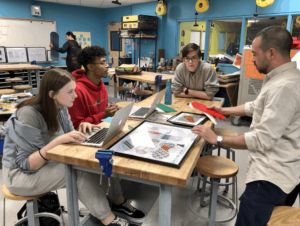Feature School: Northwest Passage
By Chad Sansing
Shane Krukowski of Project Foundry put me in touch with Jamie Steckart, director of Northwest Passage High School (NWPHS) in Coon Rapids, MN. NWPHS started 12 years ago as a chartered high school recovery program for students at-risk of disengaging with and dropping out of school. The typical student arrives at NWPHS at 17 and a half years-old, reading like a 5th or 6th grader. After two years of incremental growth, most students take-off during their third and subsequent years and leave the school reading on-grade level. Students can stay in Minnesota high schools until they are 21.
Jamie and I had a chance to talk during Winter Break, and I came away from our conversation wholeheartedly enthused by the school’s work and doubly eager for change in American public education. Here are my take-aways.
First, we need more recovery programs that offer disaffected and disadvantaged students something more than test scores, and we need to fund these programs equitably. Recovery programs like NWPHS typically have a higher transiency rate than do traditional public high schools. What this means in terms of funding is that you have to a lot of revolving-door students to equal the per-pupil funding of a more stable school population. We should be developing and sustaining recovery programs and holding them harmless for some kind of flat-rate funding of their work knowing that the first years will be rough, but that programs like NWPHS will ultimately graduate more struggling students to college, the workforce, and positive life outcomes than less specialized traditional public high schools can. At NWPHS, 60% of graduating students go on to college, while 40% do not – by choice, according to Jamie. These students begin work instead. It’s not unheard of at NWPHS for graduates of the school’s expeditions to begin high-responsibility jobs in the wilderness industries after graduation – without needing a college degree to be hired.
More broadly, we need to look at multiple economies and scales. While alternative investments and staffing models like those promoted by Rocketship speak to the fiscal exigencies of our our politics and economy, clearly schools like NWPHS help students make potent, tangible changes in their lives. How do we account for project-based schools that leverage inquiry and expedition into blended learning? We know that monocultures are weak; how do we become a national system of education localvores capable of sustaining community-building schools like NWPHS while they take-off and establish their successes with students who resist the one-size-fits all approach of traditional public schooling? Adaptive software and embedded assessment don’t have anywhere near the flexibility schools like NWPHS have in engaging all students.
Finally, in addition to funding schools like NWPHS equitably, we need to acknowledge their real value in the lives of their students, staff, and communities by letting them do what they do and by holding them accountable to more authentic standards of performance than test scores. Jamie funds his school, its expeditions, and a fairly unique apprenticeship teacher-development program with the per-pupil money he receives based on enrollment. We need to say as a public that we want schools like NWPHS – and then we need to free up innovators like Jamie, his staff, and students, to make their schools work and to show us what else is possible with the resources we have.
We need to pursue a system of public education that endorses schools like NWPHS and that embraces them as part the norm, rather than perpetuate a system that holds them at arm’s length as part of the competition.







0 Comments
Leave a Comment
Your email address will not be published. All fields are required.